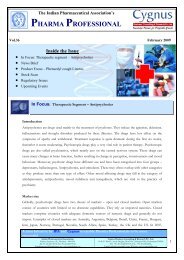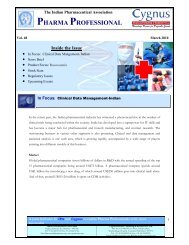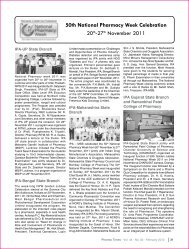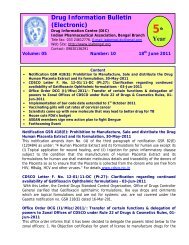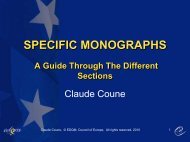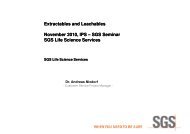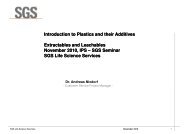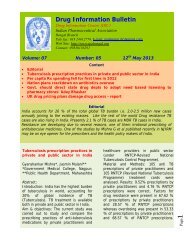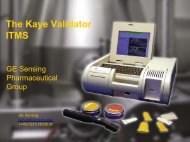Pharmacopoeial Reference Standards - Indian Pharmaceutical ...
Pharmacopoeial Reference Standards - Indian Pharmaceutical ...
Pharmacopoeial Reference Standards - Indian Pharmaceutical ...
You also want an ePaper? Increase the reach of your titles
YUMPU automatically turns print PDFs into web optimized ePapers that Google loves.
<strong>Pharmacopoeial</strong> <strong>Reference</strong><br />
<strong>Standards</strong><br />
Industry view point<br />
Antony Raj Gomes<br />
Head- Quality Management<br />
1<br />
Copyright © 2008 Shasun Chemicals and Drugs Limited
Presentation Overview<br />
<strong>Indian</strong> Industry –an update<br />
Available guidelines<br />
Industry practices<br />
Current challenges (Technical/Practical)<br />
Few case studies<br />
Regulatory positions<br />
Future trends<br />
Conclusions<br />
2<br />
Copyright © 2008 Shasun Chemicals and Drugs Limited
<strong>Indian</strong> Industry – an update<br />
‣ Fastest Growing Industry at 9% rate.<br />
‣ 4 th Largest in the World‐ volume (after USA, Europe & Japan).<br />
‣ Value of production at $15 billion (2007).<br />
‣ 300 Large Scale & 10,000 Small & Medium Scale Units.<br />
‣ Exports –from almost nil in 1960 to over $ 4.0 billion.<br />
‣ 40% of the world’s API requirement is met by India.<br />
‣ Predominant play in the Generic space.<br />
‣ CRAMS –catching up at a rapid speed.<br />
‣ Highest number of FDA/EDQM Approved facilities outside<br />
respective regions.<br />
‣ India itself is poised to become a large consumer.<br />
3<br />
Copyright © 2008 Shasun Chemicals and Drugs Limited
Available Guidelines<br />
‣ European Pharmacopoeia –5.12 (<strong>Reference</strong> standards)<br />
‣ USP general chapter <br />
‣ WHO TRS [Technical report series] 885 ANNEX 3 ‐ CRS<br />
‣ ISO guide 30 (terms and definitions)<br />
‣ ISO guide 31 (certificates)<br />
‣ ISO guide 34 (competence of producers)<br />
‣ ISO guide 35 (statistical principles for certification)<br />
‣ USFDA ‐ Guideline for submitting samples and analytical data<br />
for methods validation<br />
‣ EDQM ‐ Content of the dossier for chemical purity and<br />
microbiological quality ‐ PA/PH/ CEP (04) 1 4R<br />
‣ Industry SOP’s<br />
4<br />
Copyright © 2008 Shasun Chemicals and Drugs Limited
Definitions – WHO TRS 885 ANNEX 3<br />
‣ Primary chemical reference substance : A designated<br />
primary chemical reference substance is one that is widely<br />
acknowledged to have the appropriate qualities within a<br />
specified context, and whose value is accepted without<br />
requiring comparison to another chemical substance.<br />
‣ Secondary chemical reference substance : A secondary<br />
chemical reference substance is a substance whose<br />
characteristics are assigned and/or calibrated by comparison<br />
with a primary chemical reference substance. The extent of<br />
characterization and testing of a secondary chemical<br />
reference substance may be less than for a primary chemical<br />
reference substance. This definition may apply inter alia to<br />
some substances termed "working standards".<br />
5<br />
Copyright © 2008 Shasun Chemicals and Drugs Limited
Copyright © 2008 Shasun Chemicals and Drugs Limited
Industry Practices<br />
In-house reference standards – Drug/impurities<br />
‣ Developed and characterized by R&D/Analytical R&D.<br />
‣ Identity (NMR, Mass, IR, elemental, chiral, polymorph ).<br />
‣ Purity (chromatographic, inorganic, volatiles, complimenting<br />
‣ Orthogonal techniques –Mass balance approach).<br />
‣ Storage and directions for use ‐ determined.<br />
‣ Validity period assignment.<br />
As a start up point -> The ‘‘Joel Davis Rule’’, a historical rule-of thumb can be used, --<br />
acceptable results from 3-month stability testing of a drug product at 37– 40 0 C can be<br />
used to project a tentative expiry date of 2 years from the date of manufacture.<br />
Stressing for one week at 70 0 C would be roughly the same as 588 days at 25C. [ #<br />
<strong>Pharmaceutical</strong> Stress Testing: Predicting Drug Degradation, edited by Steven W.<br />
Baertschi ]<br />
7<br />
Copyright © 2008 Shasun Chemicals and Drugs Limited
Industry Practices<br />
Working standards – Drugs/impurities/performance<br />
evaluation standards<br />
‣ QC or Analytical R&D – defined SOP’s in the industry<br />
‣ Identity (comparison with RS/IRS).<br />
‣ Potency (Assay against RS/IRS).<br />
‣ Storage and directions for use –strategy.<br />
‣ Validity period assignment – stability data , direction for use<br />
are considered.<br />
‣ Revalidation ‐ tracking with validity of RS.<br />
‣ Multi pharmacopoeia products – stringent storage followed.<br />
8<br />
Copyright © 2008 Shasun Chemicals and Drugs Limited
Current technical challenges<br />
‣ Availability of validated analytical methods at start point.<br />
‣ Finding suitable orthogonal, non overlapping techniques.<br />
‣ Assigning the shelf life at initial time point (forced degradation<br />
–thermal stress ‐Arrhenius relation ).<br />
‣ Differences in impurity profiles and solvents between lab scale<br />
and scale up.<br />
‣ Mass value differences for impurities due to inorganic and<br />
volatile residues.<br />
‣ Response factor – validity –Variations among different lots<br />
(0.8 to 1.2. considered as 1.0? But not by all !!).<br />
9<br />
Copyright © 2008 Shasun Chemicals and Drugs Limited
Current technical challenges<br />
‣ Polymorphic/ chiral standards and contamination issues with<br />
other possible forms.<br />
‣ Limitations in available analytical techniques for structural<br />
confirmation and spectral match.<br />
‣ Possible differences in solubility profiles leading to variation in<br />
response/recovery.<br />
‣ Handling and reproducibility of residues, semi solids and<br />
liquids.<br />
‣ Transportation and purity variance issues during tech<br />
transfers<br />
‣ Assigning validity period for impurities –no stability data<br />
10<br />
Copyright © 2008 Shasun Chemicals and Drugs Limited
Current practical challenges<br />
‣ Handling and weighing of minute quantities in micro grams.<br />
‣ Storage of reference standards at the authorized dealer point<br />
–is there a need for the user to verify??.<br />
‣ Single time usage vials filled with quantities for multiple use<br />
(wastage)<br />
‣ Retrieval of small quantities, liquids in ampoules<br />
‣ ISO Guide 34 – 5.6.4 ‐ responsibility of Mfg’r to ensure<br />
integrity till seal is broken – impact of this on repeated use for<br />
qualifying secondary standards.<br />
‣ ISO Guide 34 –4.7 Client feed back – how does one keep !!<br />
11<br />
Copyright © 2008 Shasun Chemicals and Drugs Limited
Few Case Studies<br />
Compound D<br />
Chiral analysis : 95% pure (s) – (‐) α‐methylbenzyl isocyante [Chiral<br />
selective reagent ] yields 1.3% of chiral impurity A. Whereas 98%<br />
purity reagent yields 0.3%. (Monograph needs strengthening)<br />
Compound S<br />
In method B. Out of the 5 peaks that are needed to be identified<br />
using the syst.suit CRS mixture, impurity E is to be identified by its<br />
higher response related to other impurities. Though monograph<br />
simply says C18 column, it has been observed that some brands do<br />
produce lesser response for impurity E and leading to<br />
misinterpretation. (monograph strategy is not fully foolproof !!)<br />
12<br />
Copyright © 2008 Shasun Chemicals and Drugs Limited
Few Case Studies<br />
Compound F<br />
The sys.suit reference material spiked with known qty of impurity<br />
and sample analysis is in reference to this. It was observed that<br />
sample analysis showed less impurity. Investigation revealed that<br />
while preparing sys.suit ref.mat, laboratory has spiked qty of<br />
impurity without accounting for the amount of impurity already<br />
present in the drug.<br />
‣ protocol inadequacy<br />
‣ test design –not captured critical aspects<br />
‣ approval process ‐ gaps<br />
13<br />
Copyright © 2008 Shasun Chemicals and Drugs Limited
Compound F<br />
CRS Impurity expected level 0.1%<br />
CONFIRMATORY SAMPLE BY MANUFACTURER<br />
Copyright © 2008 Shasun Chemicals and Drugs Limited
Impurity – G of Compound T<br />
The Ref Std supplied by one of the pharmacopoeia was meant<br />
for TLC id test and when the same was used for in‐house drug<br />
product test for impurity, the retention time wasn’t the same as<br />
expected. Other pharmacopoeia standard yielded correct<br />
retention time.<br />
‣ may be a case of mislabeling<br />
Few Case Studies<br />
‣ possible case of approval based on Rf in TLC<br />
‣ possible gap in lot approval process<br />
‣ may be a case of degradation<br />
15<br />
Copyright © 2008 Shasun Chemicals and Drugs Limited
RT of Impurity G (Actual RT/RRT as per monograph : RT12 / RRT 0.9)<br />
RS by one Pharmacopoeia<br />
Impurity<br />
Expected Here<br />
RS by other Pharmacopoeia<br />
Copyright © 2008 Shasun Chemicals and Drugs Limited
LC Mass spectra comparison of impurity G<br />
Copyright © 2008 Shasun Chemicals and Drugs Limited
Few Case Studies<br />
Compound M<br />
The monograph specified melting range was not met by a new<br />
supplier material. When the RS was tested, that too failed!!.<br />
Investigation revealed that the monograph limits were set based<br />
on natural extracts having lower purity compared to the new<br />
source and the RS, that are derived synthetically –hence high<br />
pure and higher melting (RS evaluation did not consider<br />
relevancy of certain monograph test)<br />
‣ missed co‐relation between monograph & RS<br />
‣ protocol design<br />
‣ cant avoid industry using RS as a test conformance tool<br />
18<br />
Copyright © 2008 Shasun Chemicals and Drugs Limited
Compound R<br />
Few Case Studies<br />
The monograph requires impurity J for syst.suit of HPLC. Being<br />
extremely expensive and scarcely available, Famotidine was<br />
chosen as an alternate as it elutes as the same RT as that of<br />
impurity j. Laboratory smartly used for its in‐house method for<br />
product monograph<br />
Save efforts on isolation of impurity<br />
Cost saving<br />
Ensures availability<br />
19<br />
Copyright © 2008 Shasun Chemicals and Drugs Limited
Compound R<br />
Copyright © 2008 Shasun Chemicals and Drugs Limited
Regulatory Views<br />
EDQM<br />
Content of the dossier for chemical purity and microbiological<br />
quality ‐ PA/PH/ CEP (04) 1 4R ‐ February 2007<br />
‣ When in‐house standards/working standards, non‐official or<br />
official standards other than the appropriate Ph. Eur. CRS are<br />
employed, they have to be suitably described (in terms of<br />
identification, purity, assay, etc) and their establishment has to be<br />
demonstrated. If other standards are used instead of their<br />
respective Ph. Eur. CRS an appropriate comparison to the Ph. Eur.<br />
CRS is required.<br />
The TOP TEN deficiencies found in CEP applications (PA/PH/Exp.<br />
CEP/T (06) 35 ‐ April to July 2006).<br />
‣ Placed at Top 8 (3.2.S.5): Characterization of the reference<br />
standard (29% of the dossiers) not in comparison with the Ph.Eur<br />
CRS.<br />
21<br />
Copyright © 2008 Shasun Chemicals and Drugs Limited
Regulatory Views<br />
FDA<br />
‣ QbR Frequently Asked Questions ‐ 2.3.S.5 <strong>Reference</strong> <strong>Standards</strong><br />
[Released June 2007]<br />
‣ How were the primary reference standards certified?<br />
‣ For non‐compendial, in‐house reference standards, what type of<br />
qualification data is recommended? Will a COA be sufficient?<br />
‣ COA should be included in Module 3, along with details of its<br />
preparation, qualification and characterization. This should be<br />
summarized in the QOS.<br />
‣ It is expected that these reference standards be of the highest<br />
possible purity fully characterised<br />
22<br />
Copyright © 2008 Shasun Chemicals and Drugs Limited
Regulatory Views<br />
Health Canada [GMP Q and A on Health Canada Site]<br />
Q. What is the Inspectorate's position on the use of secondary<br />
reference standards and what are the conditions for the use of<br />
secondary reference standards?<br />
A. While the Inspectorate recommends the use of the official<br />
standards for the analysis of compendia articles, the use of a<br />
secondary RS is acceptable if each lot's suitability is determined<br />
prior to use by comparison against the current official reference<br />
standard and each lot is re‐qualified periodically in accordance<br />
with a written protocol. The protocol should clearly address the<br />
receipt, storage, handling and use of primary reference standards,<br />
the purification of secondary standards, and their qualification<br />
against official reference standards.<br />
23<br />
Copyright © 2008 Shasun Chemicals and Drugs Limited
Regulatory Views<br />
Health Canada [GMP Q and A on Health Canada Site]<br />
Q. Is it acceptable to use a third party lab's available pharmacopoeial<br />
reference standard to qualify an establishment's secondary<br />
standard?<br />
A. This practice is acceptable providing the contract testing lab has an<br />
Establishment License (EL) and has been audited by the client to<br />
demonstrate its capability to qualify the secondary standard (ie.<br />
the official standard and the proper equipment is available on the<br />
tester's premises, the method used has been validated, etc.).<br />
Transfer of the standard between the sites should be under<br />
controlled conditions.<br />
24<br />
Copyright © 2008 Shasun Chemicals and Drugs Limited
25<br />
Future Trends<br />
Certified <strong>Reference</strong> Materials (USP) –the usage of metrology.<br />
Multi method monograph (USP initiative)‐ strategy for syssuitability<br />
/specific impurity markers (labeled for the test??).<br />
Industry and regulatory understanding of assigned uncertainty in<br />
case of CRM’s – revision of general chapter, internal SOP’s ,<br />
regulatory guidelines ?!!<br />
Performance verification standards –tests and technique.<br />
Closer interlinking of monograph instructions and RS design<br />
(especially syst.suit applications).<br />
Polymorphic impurity standards.<br />
Genotoxic impurity standards.<br />
Copyright © 2008 Shasun Chemicals and Drugs Limited
Future Trends<br />
Improved analytical capabilities for assigning true potency<br />
Harmonization among USP / EP / BP / JP on common molecules<br />
(storage and direction for use at least)<br />
Orthogonal testing for potency confirmation.<br />
Defining scientific storage conditions –lesser temperatures may<br />
not be better in all cases.<br />
Cold chain integrity proof –data loggers ‐for critical items ??!!<br />
<strong>Standards</strong> beyond monographs<br />
Elution order based identification RS mixtures – monograph<br />
strategy for column selectivity ?!!<br />
Enhanced industry participation on collaborative testing ?!<br />
26<br />
Copyright © 2008 Shasun Chemicals and Drugs Limited
Conclusions<br />
RS characterization gets more and more complex due to various<br />
elements – need to look for analytical solutions beyond monograph<br />
Secondary standard –though an economical option ‐ not always<br />
provide the same assurance of a primary standard‐ Appropriate<br />
evaluation measures to be in‐built in the process<br />
Next level of compliance – stability based validity for impurities,<br />
cold chain adherence at all time for critical items, etc<br />
Industry needs guidelines that reflect solutions for current<br />
challenges and provides insight on future possibilities.<br />
Harmonization –at least to an extent that is beneficial to the<br />
industry<br />
Greater industry participation !!<br />
27<br />
Copyright © 2008 Shasun Chemicals and Drugs Limited
28<br />
Copyright © 2008 Shasun Chemicals and Drugs Limited



